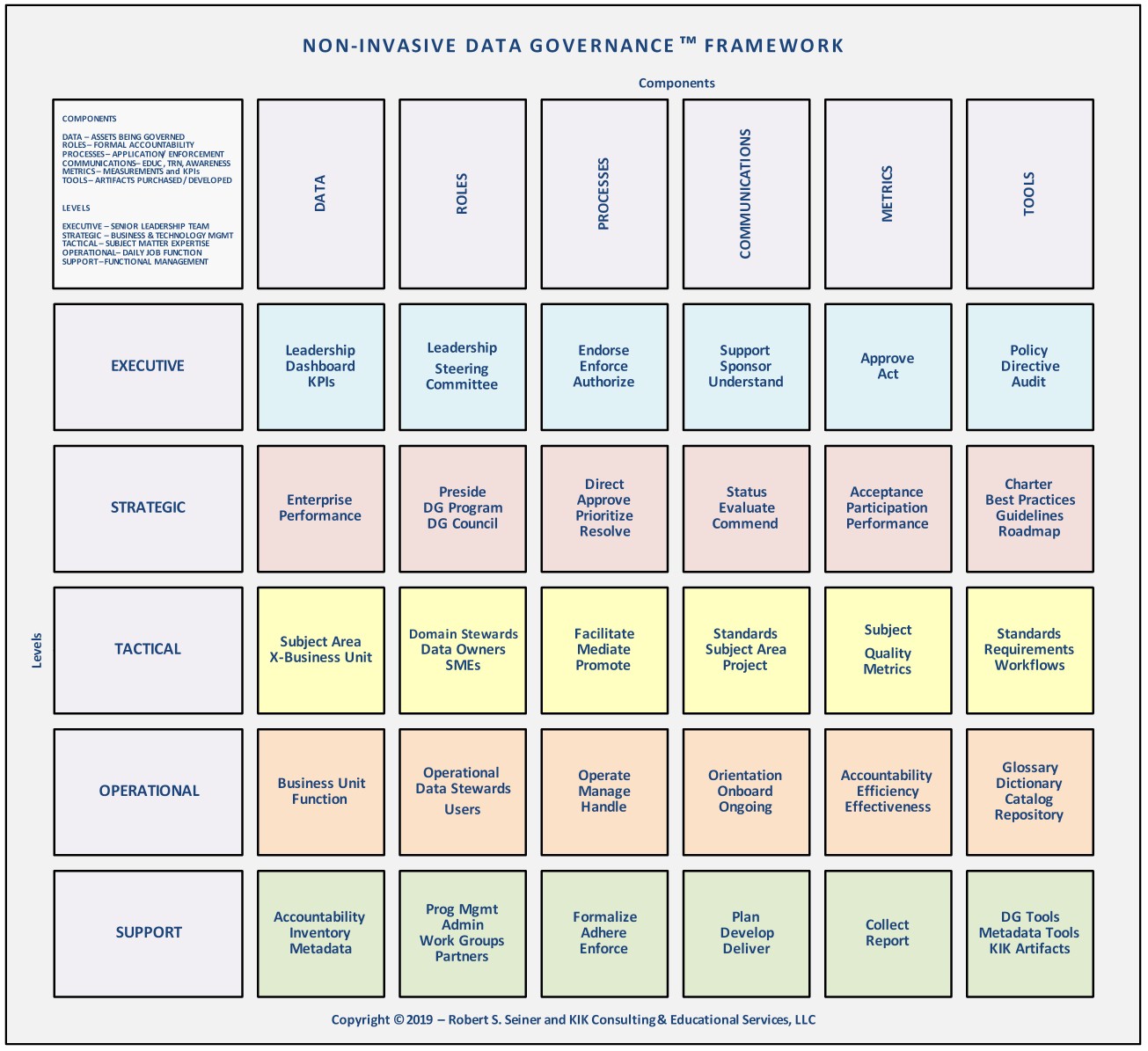 Part one of this series addressed the structure of the Non-Invasive Data Governance Framework. In part two, I detail each of the labels on the rows and columns of the framework.
Part one of this series addressed the structure of the Non-Invasive Data Governance Framework. In part two, I detail each of the labels on the rows and columns of the framework.
I refer to the row labels as the Levels or perspectives of the organization and the column labels as the Core Components of a successful Data Governance program.
As a reminder of the framework structure, I am sharing the completed framework below.
In the final part of the series I will detail the components at each of the levels described here.
The Framework Levels (Rows)
The levels of the Data Governance Framework represent the levels of the organization. The names given to the levels are typical of many organizations, however, they may not be the same as what you call them. Many organizations talk about “right-sizing” the program for their specific needs and using names that closely echo the organizational culture. Eliminating levels is more likely than adding levels.
Executive
The Executive level of an organization typically consists of people at the top level. This includes Presidents, Chairs, Senior Vice Presidents, and CXO level positions (meaning CEOs, COOs, CIOs, CDOs, CROs, CMOs, etc.). The Executive Level of an organization often has regular or scheduled meetings as the Steering Committee for the enterprise.
In Non-Invasive Data Governance (NIDG) – Data Governance is added as a line item on the agenda of regular Executive level meetings. The Steering Committee is composed of business and technology leadership for Data Governance and all other Enterprise level initiatives.
Strategic
The Strategic level of an organization typically consists of people that report directly to and are delegated by the Executive level to oversee and direct specific initiatives. This can include Senior Vice Presidents, Vice Presidents, and the people that are recognized as being second-in-command or as representing their part of the organization in the initiative. The Strategic level is accountable to the Executive level for the success of the initiative.
In NIDG – The Strategic level is often labeled as the Data Governance Council. The Council’s responsibility is to make certain the Data Governance program is successful. The Council is very knowledgeable in the policies and procedures of Data Governance and acts as the ultimate decision maker for resolving issues that cannot be resolved at a lower level of the organization.
Tactical
The Tactical level of an organization typically consists of people that are subject matter experts, facilitators, and potentially decision makers for specific domains of data and information. The Tactical level is delegated or recognized by the Strategic level as people that must be included in and drive decisions that are made regarding data in their domain. The Tactical level can be defined by policy, through appointment, or through a natural selection process (the “go-to person”).
In NIDG – The Tactical level is often labeled as Data Domain Stewards or Enterprise Data Stewards for a specific subject matter of data. Domain Stewards are recognized for their expertise in their subject matter across the Enterprise. This role is the most critical role of an NIDG program and can be the most logical or difficult to fill. Domain Stewards can have the authority to make Enterprise decisions for their subject matter or they may escalate the decision to an information Strategic level.
The Tactical level may also include Information Owners – although the author of this framework suggests to avoid the use of the term “owner” when possible. The Information Owner label can be appropriate in situations where rules must be followed in a specific part of the organization.
Operational
The Operational level of an organization typically consists of every person in the organization that has a relationship to data and is (or will be) held formally accountable for that relationship. The relationships include the definition, production, and/or use of data and information. If an individual does any or all of these activities as part of their job, it is a requirement that these people follow policy, best practices, and standards for that relationship. The key focus of Data Governance is to assure that select high quality data is reused and handled appropriately.
In NIDG – The Operational level can include everybody in the organization. These people are known as the true stewards of the data – or people that are or will be formally accountable for how they define, produce, and use data. These people do not require a title of Data Steward. From the operational and on up through the hierarchy, people must be held formally countable for their actions associated with the data. In NIDG, specific and thorough attention is paid to governance awareness at all levels whether that awareness focuses on quality, protection, or management of the data.
Support
The Support level of an organization typically includes the people responsible for the Data Governance program, the supporting knowledge of Information Technology (IT), Project Management (PMO), Regulatory and Compliance groups, Information Security, Legal and Audit, and Working Groups— any group that has a vested interest in the “execution and enforcement of authority over the management of data.”
In NIDG – The Support level varies with the program design in each organization. Leadership of the Data Governance program is the critical level of support, and the support and involvement of IT and the PMOs act as stalwart contributors to the most successful programs.
The Framework Components (Columns)
The components of the Data Governance Framework are the core significant pieces of putting together a successful Data Governance Program. The core components should be considered as pieces that the program cannot do without. Many practitioners talk about people, processes, and technology as being the lynchpins of a successful program. I have added two components and have a different spin on technology.
Data
The scope of the resources that are being governed is the first core component of a Data Governance Framework. Organizations with formal programs can learn from, and should differentiate between data, information, records and knowledge.
In NIDG – The approach to governance is very similar across each of the different data resources, including the execution and enforcement of authority and the formalization of accountability for the data resources that are in scope.
Roles
The first foundational component of a successful Data Governance program is the definition of roles and responsibilities. The manner in which roles are defined is a predictor of the effort required to govern the data. Assignment into roles often presents pushback when the effort is over-and-above existing responsibilities. Identification into roles encounters less pushback as people see themselves in the roles that they have been slotted. The recognition of people into roles is a direct manner of acknowledgement of the part each person plays in the program.
In NIDG – Roles are typically represented through an NIDG Operating Model of Roles & Responsibilities. The familiar pyramid diagram is represented in the first column of the NIDG Framework. The Operating Model and accompanying artifacts provided as part of the approach include a detailed description of formalized responsibilities, escalation and decision paths, how roles are formally engaged in processes, and communications that are shared with each level.
Processes
The second foundational component of a successful program is the way that Roles are applied to processes. The notion of the “Data Governance process” misrepresents the fact that processes are a primary component of Data Governance success. There is not a single process that is governed, rather there are a series of processes to which Data Governance will be applied.
In NIDG – Data Governance programs typically provide repeatable processes that reflect the appropriate level of formal accountability throughout the process. Data Governance focuses on getting the “right” person involved in the “right” step of the process to deliver the “right” result regardless of the process focus – issue resolution, protection, quality, project-focused; Data Governance becomes the application of formal governance to process.
Communications
Communication is an important component of a successful Data Governance program. Raising the data awareness of every person that defines, produces, and uses data is critical to achieving program success. Education must focus on policies, handling rules, best practices, standards, processes, and role-based governance activities.
In NIDG – Communications play a role in every aspect of program definition and delivery. Communications must be thorough and measurable. Communications must focus on formalizing accountability for the processes mentioned above: issue resolution, protection, quality, project-focused, or any other application of authority to how data is managed.
The Communications Plan must mirror the Roles component described above. Communications must include orientation, on-boarding, and ongoing subjects focused toward the specific audience while utilizing available communication instruments.
Metrics
Data Governance programs must be able to measure their impact on the organization. This is the responsibility of the Support role often called the Data Governance Lead and Team. The impact and value may be financially quantifiable, but this may not always be the case. Measuring efficiency and effectiveness improvements require benchmarks of present state and the governed activity of measuring and reporting results.
In NIDG – Organizations measure improvements in governance through collecting and reporting the number of issues recorded and addressed, while also quantifying the value of issue resolution, quantifying education, awareness, and certification of handling rules and incidents that are formally attended.
Data Governance metrics and measurements must be auditable and demonstrable to management and authorities when requested. Organizations typically count the reusability and understandability of data definition, the ability and speed to access the “right” data at the “right” time, the production of high quality data, and the proper usage and handling of data.
Tools
Tools of Data Governance enable the program to deliver value to the organization. Organizations use tools they develop internally as well as tools that they’ve purchased to fill specific needs of their programs. The tools that are developed or purchased are based on practicality, ease-of-use, and the specific goals of the Data Governance program.
In NIDG – Tools are used to formalize accountability for the management of data and improve the knowledge of the data, rules, and processes required to govern data. Tools are used to record and make available metadata in order to improve the understanding and quality of data across the Enterprise.
The Data Governance Tool market is growing as the definition of Data Governance expands to address authority enforcement over big data, smart data, metadata and all data used for analytics. Prior to investing in new technologies, organizations should clearly state their requirements, consider leveraging existing tools, and develop tools internally to address specific metadata needs of their Data Governance program.
In the final part of this series, I will detail the core components of a successful Data Governance program at each of the levels or perspectives of the organization. As you can see in the completed framework, the details at each intersection of level and component are what truly make the framework non-invasive.

